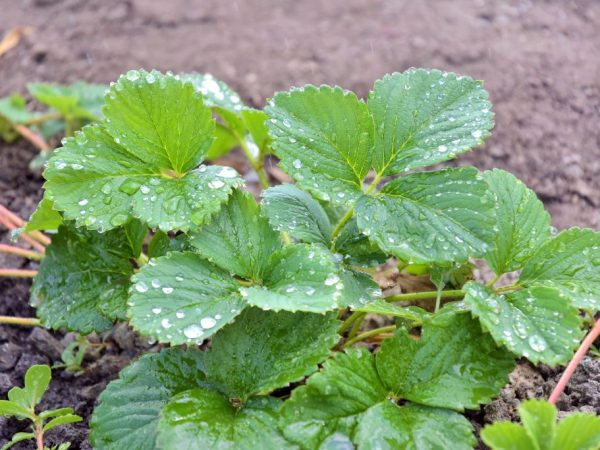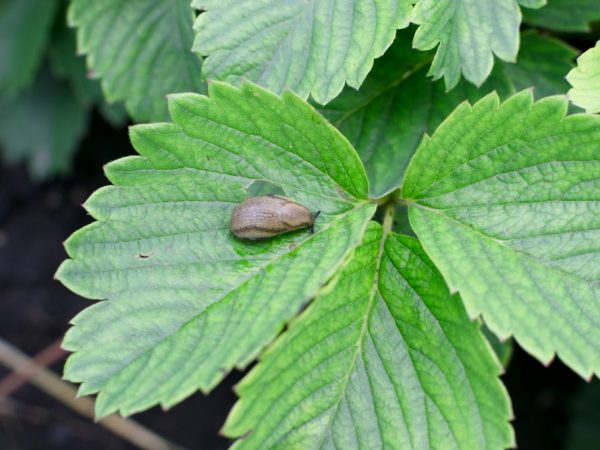Autumn strawberry processing - important tips
Throughout the entire period of growth and development, strawberries are damaged by various parasites and diseases, therefore, chemical preparations cannot be dispensed with. Correct and timely care is a preventive measure. Consider how to treat strawberries in the fall from pests and diseases and how to do it correctly.

Autumn strawberry processing - important tips
Features of autumn care
Preparing strawberries for winter includes therapeutic measures to combat pathogenic microflora in the soil and on bushes.
Most harmful insects and diseases cause colossal harm to the plant:
- some suck juices from leaves, stems, flowers;
- others gnaw holes in the root system;
- still others like to feast on ripe berries.
When infected with diseases, there is a high risk of wilting, drying out and death of plants. All this leads to the loss of planting material and a decrease in crop productivity. Autumn processing with pesticides will help to avoid such consequences.
Strawberries need good care throughout the season - you need to regularly inspect the bushes for infection and parasites, remove and burn diseased specimens in time, weed the aisles, pull out weeds, remove dry foliage and stems.
Bushes with deformed, stained, eaten leaves, thickened stems are also subject to removal.
If a garden bed is damaged by a nematode, it is recommended to dispose of all bushes, treat the soil with chemicals, followed by planting spicy plants - marigolds, tansy, calendula.
They start processing after harvesting, because it is forbidden to use pesticides during fruiting - the berries absorb it and become unusable.
- Common varieties are irrigated in late September or early October.
- For remontant, the dates are shifted closer to winter, since this culture bears fruit before the frost itself.
Processing recommendations
Autumn processing of strawberries must be carried out necessarily in dry, calm and cloudy weather or in the evening, so as not to burn the aboveground part of the plants.
At the same time, the rules must be observed:
- it is necessary to strictly observe the dosage for the preparation of chemical solutions, otherwise you will destroy not only pests, pathogens, but also the bushes themselves;
- after rain, re-treatment should be carried out, since water washes away the active components and reduces their duration;
- irrigation is carried out carefully on the leaf on both sides; the stems and soil under the bushes are also sprayed, in which the larvae of pests and infectious agents often live;
Depending on the stage of the lesion, several treatments may be needed, usually with an interval of 7 days.
Treatment of diseases

Diseases can kill plants
In autumn, the immunity of the berry crop is weakened. At the first symptoms of the disease, it is necessary to take measures to save the plant.
| Name of the disease | A drug | Processing rules and dosage |
| Gray rot | Horus, Alirin-B, Fitosporin | For spraying, choose the day when the temperature reaches 3 ° C. As the indicators increase, the maximum effect of the action is manifested. Dosage according to the instructions on the package. Treatment with Ailirin-B is carried out several times per season (before and after flowering and after harvesting). Both pesticides can be used for prophylaxis. Phytosporin is irrigated after picking berries, the proportion is 1:20 (preparation-water). Additionally, you can carry out processing closer to winter (in mid-November) |
| Powdery mildew | Fundazol, copper sulfate solution, Bordeaux mixture, Topaz | A chemical preparation belongs to contact pesticides. Dosage - 10 g per bucket of water (per 1 m² plot). When treating with copper sulfate, it is necessary to prepare a solution of 300 g of the substance per 10 liters of water. Bordeaux mixture of 3% has a strong effect - they irrigate the soil and bushes. Topaz treatment is carried out in dry and calm weather, creates protection for two weeks. Prepare the working staff according to the instructions |
| Anthracnose (black spot) | At an early stage, Ridomil Gold, Quadris and Metaxil are used. On running - use Bordeaux liquid (1%) | Enough two treatments of leaves, stems and soil with an interval of 7 days. Severely damaged plants are removed, burned, and the land where they grew is spilled with a strong solution of potassium permanganate. |
| White, brown and angular spotting | Fungicides (copper sulfate solution or Bordeaux liquid) | Spraying is carried out four times a year - before the budding period, after picking berries, in mid-August and in the first half of September |
| Red spot | Iodine | They are processed three times per season - at the beginning of spring, before flowering and after the end of fruiting. Dosage - ½ tsp of iodine in a bucket of water. To make the product adhere better to the leaves and stems, add 1 tsp of liquid soap to the working fluid. |
| Black rot | Ordan | You need to process the aboveground part and the soil under the bushes. Dosage according to the instructions. The frequency of the procedure is twice with an interval of 7 days after picking the berries. |
| Root rot | Treatment is not subject | The bushes are dug up and burned. The soil is spilled with a solution of copper sulfate or potassium permanganate, then dug up. Preventive measures - timely disposal of diseased specimens, weeding, loosening, removing weeds. |
| Viral diseases (mosaic, mottling, berry sprouting, wrinkling, marginal yellowing of leaves) | Sores that are difficult to treat, spread quickly, and are easier to prevent | To avoid infection, thickening of the plantings should be avoided, strong seedlings should be taken, regularly loosened aisles, and harmful vegetation should be removed |
| Late blight | Fundazole (0.2%) | Two-time autumn processing of the bushes and the soil under them is required. It is also required to provide the plants with good drainage. |
| Fusarium | Potassium oxide | Close up in the soil under the bushes while loosening. Additionally mulch with vinyl film. |
| Greening the petals | Karbofos, infusion of garlic, ash and soap solution | You need to process it twice with an interval of 7 days. Garlic is prepared at the rate of one head per 1 liter of water. To prepare the ash-soap composition, take 100 g of ash and 1 tsp of liquid soap per 3 liters of water. |
| Verticillary wilting | Treatment of the disease is impossible, but the biological product Gumat K is used for prophylaxis. | Before planting, the root system of the seedlings is dipped in a solution. |
| Chlorosis | inkstone | The root zone and plant leaves are sprayed. |
Pest control

It is necessary to get rid of pests
In addition to diseases, strawberries have many harmful insects that destroy leaves, stems, flowers and berries.
| Name | How to process | Rules and Schemes |
| Whitefly | Actellik, Confidor, Rovikurt, Pegasus | Apply no more than four times per season, the amount of the drug according to the instructions |
| Weevil | Karbofos | Processing is carried out twice - before flowering and after harvesting.For prophylaxis, additionally spray with tincture of red pepper (½ tsp for 5 liters of water). Folk remedies are also used - they spill the bushes with hot water, treat with a solution of mustard and laundry soap, plant in the aisles of aromatic plants - onions, garlic |
| Ticks (spider and strawberry) | Onion husk solution | Three-fold irrigation with the preparation. Cooking - a bucket of husks is poured into 5 liters of water, insisted for two days, then filtered |
| Nematoda (gallic, strawberry and stem) | Ferrous sulfate solution (5%) | First, all damaged bushes are removed from the site, then the soil and the aboveground part of healthy plantations are sprayed. For autumn processing, dry, calm and cloudy weather is required. |
| Strawberry leafworm | Karbofos (10%) | In autumn, plant debris, leaves, pest nests are removed. After harvest, processing is carried out. |
| Pennitsa | Laundry soap solution | We spray with a highly concentrated liquid - 40 g per 1 liter of water. |
| Slugs and snails | Superphosphate | First, burdock stalks or moistened rags are laid around the bushes. Collect pests by hand, then sprinkle superphosphate on the near-stem zone of each plant |
| Caterpillars | Tefluthrin | Root applied before flowering and after harvest |
| Aphid | Infusion of garlic, onion peel, ash and soap solution, ammonia | Spray the bushes and the soil under them. For prevention, fragrant plants are planted between the rows - fennel, dill, marigolds, tansy. Treatment with ammonia is carried out for preventive purposes. |
| Strawberry leaf beetle | To scare away, use tobacco dust. They are treated with Karbofos | Sprinkle tobacco between the rows, then process the bushes with a solution of 75 g of substance per 10 liters of water |
| Ants | Wood ash | The anthill is treated with the agent (500 g per 2 liters of hot water). Then, frightening crops are spread between the bushes - anise, mint or tansy. |
For high-quality protection of the strawberry plantation, you can use urea (1 tbsp. L. The substance is dissolved in 10 liters of water). The bushes and the soil under them are sprayed a month before the onset of cold weather.
This complex fertilizer increases the immunity of plants, so they do not get sick in winter and have good resistance to cold weather.
Summing up
Strawberry processing in the fall is carried out in order to prepare it for winter.
Fruit and berry culture after the end of fruiting becomes weakened, easily damaged by various diseases and pests.
To protect and control them requires the use of a variety of chemicals. If you follow the rules of application and dosage, you can maintain the health of the bushes, and get a good harvest next year.

